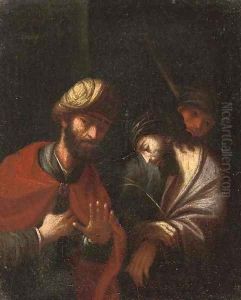Mattia Pretti Paintings
Mattia Preti, also known as Il Cavalier Calabrese (The Knight of Calabria), was an Italian Baroque artist born in Taverna, a small town in Calabria, on February 24, 1613. His artistic journey began under the guidance of his brother Gregorio Preti, who was also a painter. This foundational period was crucial, as it embedded in Mattia a keen eye for detail and a profound appreciation for the Baroque style, which was characterized by its dramatic use of light and shadow, intense emotional expression, and a focus on realism and movement. Mattia’s talent soon necessitated a move to Rome, where he was able to immerse himself in the dynamic and competitive environment of Baroque artistry, studying the works of masters like Caravaggio and absorbing their techniques.
Preti’s work in Rome was marked by a rapid evolution of his style, as he increasingly employed the tenebrism (sharp contrasts of light and darkness) that Caravaggio popularized, while also developing a distinctive approach characterized by vigorous brushwork and a rich color palette. His reputation grew, making him a sought-after artist for commissions by churches and for private collections. In the mid-17th century, Preti received a knighthood from Pope Urban VIII, a testament to his increasing prominence in the art world and the high regard in which he was held.
In 1659, Preti moved to Malta, where he would spend the majority of his later life and where some of his most significant works were created. He was commissioned by the Knights of Malta to decorate the vault of the St. John’s Co-Cathedral in Valletta, a monumental project that would become one of his most renowned achievements. The frescoes he painted there are considered masterpieces of Baroque art, showcasing his mature style and his ability to convey complex biblical narratives with emotional depth and visual splendor. Preti’s influence in Malta extended beyond this magnum opus; he was involved in numerous other projects, contributing significantly to the cultural and artistic heritage of the island.
Mattia Preti’s works are celebrated for their dynamism, their intricate play of light and shadow, and the emotional intensity of their subjects. Beyond his technical mastery, Preti’s paintings are noted for their humanity and for the artist’s ability to infuse his figures with a sense of life and vibrancy. His legacy includes not only the magnificent frescoes in Malta but also a wide array of canvases that are housed in some of the world’s most prestigious museums. Preti died on January 3, 1699, in Malta, leaving behind a body of work that continues to be admired for its contribution to the Baroque movement and its enduring beauty and power.
